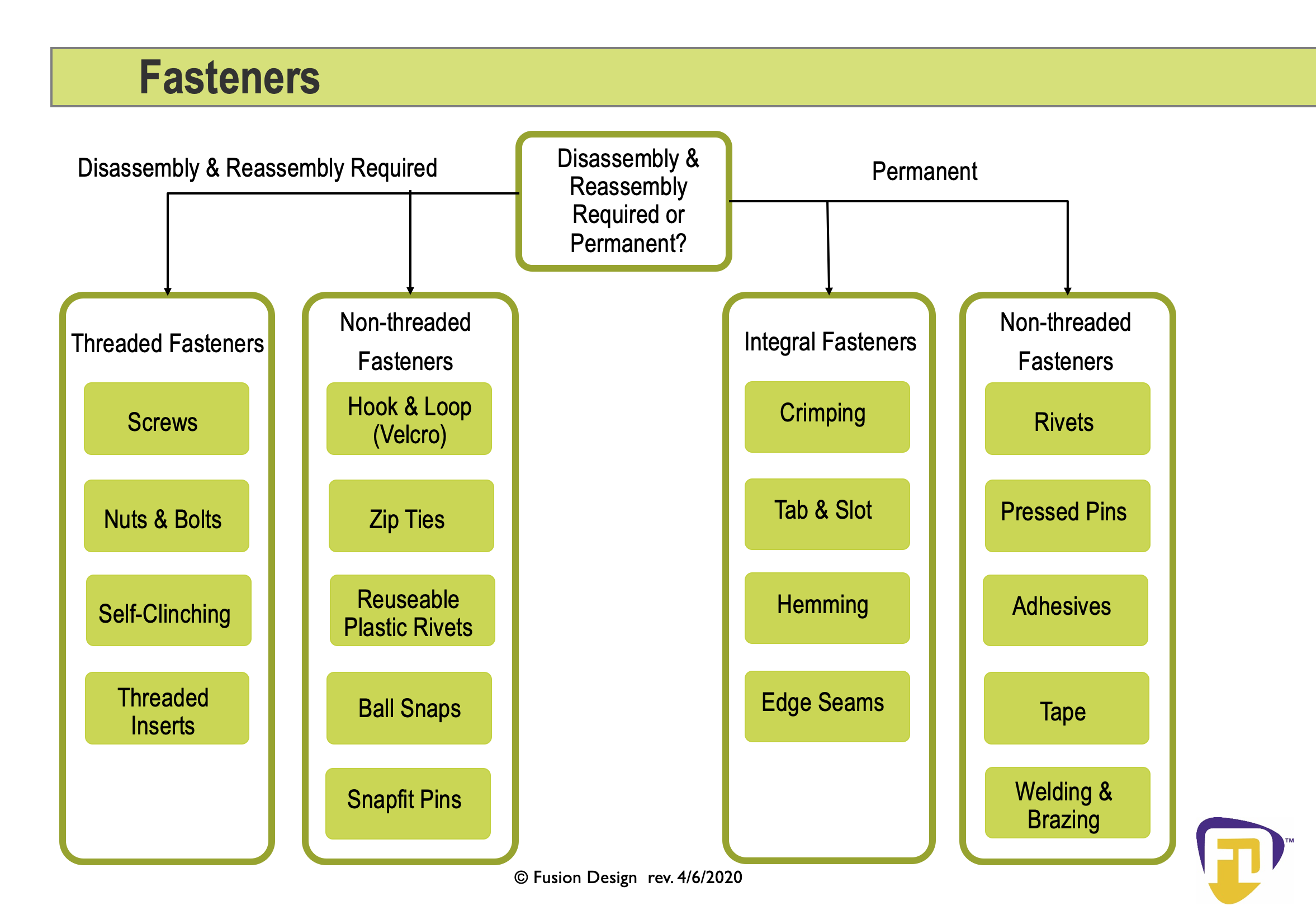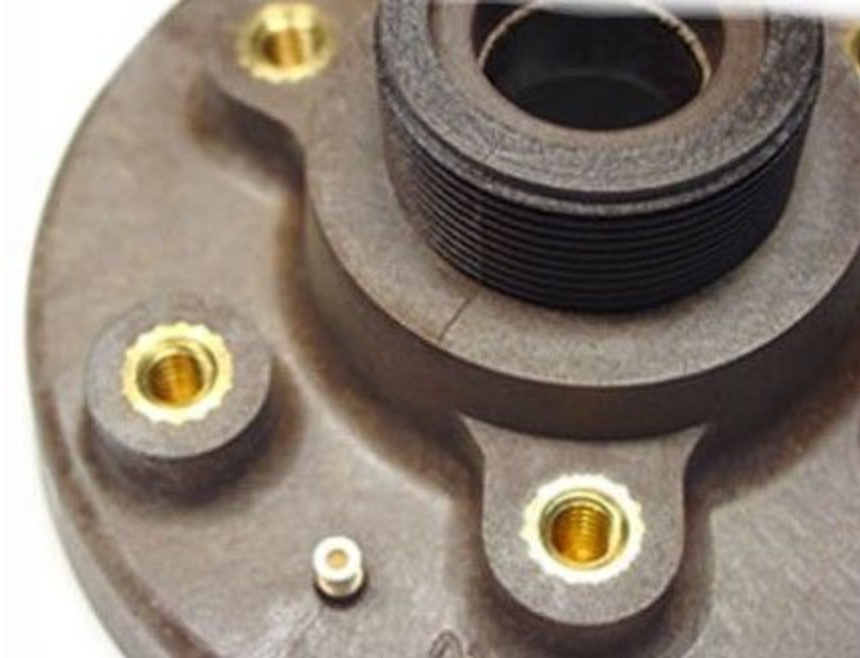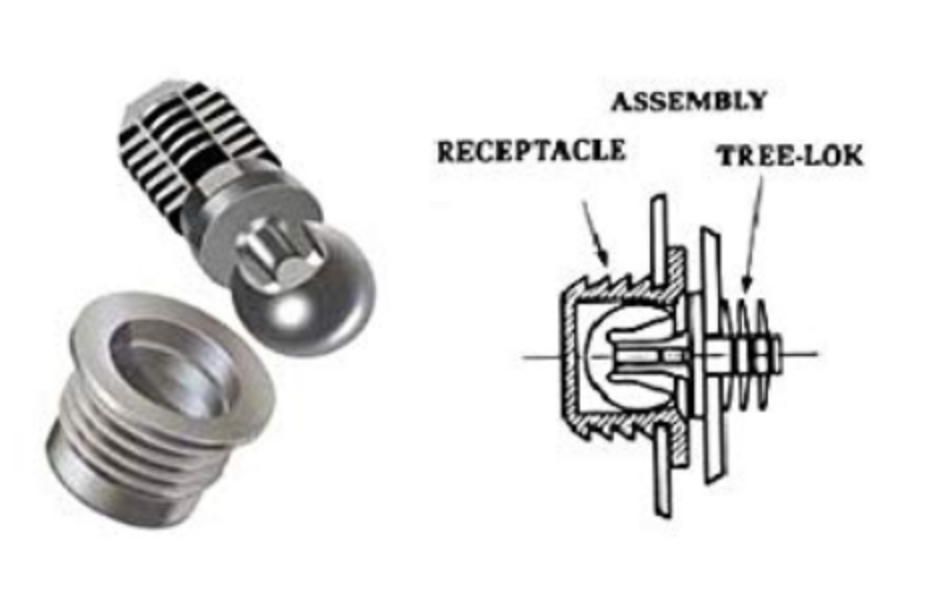Assembly in manufacturing consists of fastening various components into either a functioning unit or a higher level subassembly. A fastener mechanically joins or affixes two or more objects together. There are numerous types of mechanical fasteners, bonding solutions, and adhesive taping methods. We start each new project by defining what is needed from an overall mechanical point of view. Fastening approaches are one category of early interest.
We look at the influencers for specific selections including:
What is the size of the product?
What are the cost targets?
Is it a low volume or a high volume product?
What are acceptable lead times?
What is the function of the product?
Is it a rugged application?
Is it a lightweight product or a heavy product?
What are the aesthetics goals of the product?
Is it a plastic enclosure or a metal one?
Will it be used indoors or outside?
Are there special safety and regulatory considerations?
Is it in an aggressive environment or a non-aggressive environment?
What are the serviceability requirements?
Do they need to be removable? How many times?
There are thousands of different types of fasteners and the chart below shows the most common ones we use. When possible, we try to use readily available fasteners, and we try to minimize the different types in each project.
These are common options we use for fasteners.
Threaded fasteners
Integral fasteners
Non-threaded fasteners
Image source: https://www.mcmaster.com/fasteners
Threaded Fasteners
Threaded fasteners are easily removed where disassembly and reassembly is required. They are generally low cost and widely available.
Common types:
Screws
Nuts and bolts
Self-clinching fasteners
Threaded Inserts
Hex head bolts are popular because they can provide greater clamping pressure if there is enough room for a wrench. In tight spots, a socket head cap screw might be a good option. With the hex head screw’s greater clamping pressure, you use fewer screws for a given job and this benefits production because fewer holes are required to be drilled and tapped. Additionally, there is a weight reduction as fewer screws are used. The exception may be in the case where screws are used to clamp a seal. A greater number of screws can be an advantage to prevent enclosure distortion and even seal clamping pressure.
Note that all threaded fastener applications should consider washer for head load distribution and lock washers for torque retention. Basically you want to prevent the screw or bolt from damaging the parts while making sure they do not vibrate out during transportation or general use.
Self-tapping screws are ones that create their own thread as you put them in. Very commonly used in plastic parts or soft mediums.
For plastics, we will often use threaded inserts which are usually a brass or steel nut. They employ press-in, molded-in, or heat/ultrasonic installation methods to provide strong, reusable, permanent threads in plastic. They can be fastened and taken apart multiple times. If you're only going to take it apart once or not at all, you use a thread forming screw which uses the plastic as the nut.
The number of assembly cycles expected is a prime driver for the selection of a threaded insert. The second prime driver for the selection of a threaded insert is force or retention force. A threaded insert gives more pull force than a thread cutting screw, which uses plastic. It's retention force.
Our most used resource for sourcing and sizing screws and bolts is the engineering slide chart.
https://apps.apple.com/us/app/the-engineering-slide-chart/id518126409
https://youtu.be/zytccDbHy1g
An often overlooked aspect of using threaded fasteners is the proper torque setting for a particular application. The selection of the proper twisting force needed is primarily a combination of the screw / bolt capacity and the materials that it is holding together.
Integral Fasteners
Tab & slot
Integral fasteners are formed areas designed into sheet metal or plastic products that function by interlocking or interfering one component with other components during assembly.
Common types:
Tab & slot
Crimping
Edge seams
Hemming
The tab & slot design is a construction technique for sheet metal assembly that works well in many cases. The edges of both parts are usually cut with tabs and slots to secure them together and these can be welded together or can have a few other fasteners to provide a very strong well aligned assembly.
Integral snaps are used for plastic parts with two shells, an outer and an inner shell. Often called clamshells, these will have electronics inside. You push them together, and they have little wedge-shaped features which fall into small slots in the mating part.
After they snap together, generally, they do not come apart.
Non-Threaded Fasteners
Non-threaded fasteners are not integral because they are added to the part and are bought and installed separately. Some joints can also be welded or brazed together.
Common Types:
Rivets
Pins
Snaps
Adhesive
Tape
Hook and Loop (Velcro)
Zip ties
Pin and Hole
Ball Snaps
Pins are commonly pressed into one assembly part and slipped into another assembly part to ensure accurate and repeatable alignment of the two components. We mostly use pins that we use are a cylindrical style type pin or a rolled spring pin. The rolled steel spring pin applies an outward force based on the hole size it's being pressed into.
The pin and hole design has a pin on one side and a matching hole on the other. When pressed together the pin slips into the hole, aligning the pieces and holding them together. It becomes a pseudo-fastener in that it locates two parts relative to each other. If you pull in a certain direction, the parts will come apart but will not come apart if you go pull across the pin.
Used primarily for alignment, they are a reliable way to repeatedly mount two parts together with tight tolerances. Typically, the pieces are then secured with threaded fasteners. Pins do the precision alignment and screws do the final retention.
Ball snaps are intended to be inserted and removed multiple times. They are almost always metal, with quick installation, and are based on a simple snap connection.
Adhesives
There are millions of adhesives. Here are five things that are important when considering and looking at adhesives:
Types of materials that are being adhered together
Size of the surface area to be bonded
Resistance to temperature and environment
Curing time
Ease of application
Holding force
Fatigue factors
All adhesives have a temperature range of operation. For example, RTV is a silicone rubber with an extremely high melting point and is commonly used because of its wide range of temperature performance. You can put a lighter flame on silicone, and it won’t melt. It might change color a little bit, but it won't melt, and it does not burn easily. RTV also performs well at low temperature also, but it does get more brittle as it gets colder. It is necessary to consider the temperature swing it will need to withstand.
Another favorite adhesive we use is a thermoplastic adhesive from Loctite which is a superglue that can actually flex. Generally, it doesn’t require mixing and is a room-temperature curing adhesive. It is typically used for bonding rubber, polystyrene, wood, metal, and plastics together. Amazing stuff.
Tape
Tape is a quick way to create water resistance or a quick fastening scheme for an early prototype that ultimately will be bonded with RTV or some other epoxy type adhesive. We typically don't want a permanent bond in a prototype so we can take it apart. Tapes are great for temporary adhesion, but permanent adhesion can be done with them as well. There are as many tapes as there are adhesives out there.
There is a permanent tape called flex tape which sticks to almost anything, even when applied in water. You can go underwater and plug a hole in a boat with this tape to create a permanent seal. This is great IF you do not want to remove it. It is very, very sticky.
Zip Ties
Zip ties are used for bundling of cables and wires, and also for attaching tags. They are fast and flexible and come in different sizes, from a few inches to several feet long. They are capable of holding quite a bit of force and are pretty good in most environments. Steel bands are metal versions of zip ties and are often used outdoors. You often see them holding electronic enclosures onto telephone / power poles.
Hook and Loop (Velcro)
Velcro invented it, but there are hundreds of hook and loop makers. They are easy-to-use touch and close fasteners with good shear force and they come in many different retention force / pull-apart strengths. They are great for quick lightweight closure of pockets, tethers, and similar situations.
Typically they are an adhesion-backed solution although they can be sewn on to fabrics. The most common is a lightweight, low force fastener but there are industrial grades widely used in the automotive industry. The industrial grade has an adhesion capability similar to that of flex tape. Basically car body panels can be held in place with these solutions.
Application Examples
There are millions of types of fasteners and we have barely touched the surface. So much is dependent on the needs of the application and we thought it would be best to talk about a few fasteners used in typical applications.
Outdoor Enclosure
For an outdoor enclosure that needs to be serviceable, a good choice would be a screw fastener design that has lock and flat washers. Sometimes we use them with o-ring typ washers for water sealing. The screws materials are often stainless steel for weather resistance. Socket Head Cap Screws (SHCS) are often our favorites.
For a plastic enclosure, we like to use threaded inserts so it could be taken apart and put back together. If screws are run straight into plastic, the plastic would be ruined after two or three cycles and will no longer work.
Underwater Product
For an underwater product that will never be taken apart, it would typically be bonded with an adhesive that's resistant to the chemistry of the environment and safe for the application use, whether it's in the ocean or in a pot of boiling water. The adhesives would have to withstand specific application pressures and temperatures.
Summary
These are only a few different applications for fasteners, but there are thousands of others. We hope these examples help outline the decision making we go through when selecting a fastening approach. Regardless, a systematic approach considering function, aesthetics, environment, manufacturing and assembly is the key to success.







